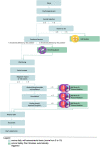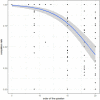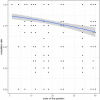Acceptability and satisfaction with emma, a smartphone application dedicated to suicide ecological assessment and prevention
- PMID: 36032223
- PMCID: PMC9403788
- DOI: 10.3389/fpsyt.2022.952865
Acceptability and satisfaction with emma, a smartphone application dedicated to suicide ecological assessment and prevention
Abstract
Background: As mHealth may contribute to suicide prevention, we developed emma, an application using Ecological Momentary Assessment and Intervention (EMA/EMI).
Objective: This study evaluated emma usage rate and acceptability during the first month and satisfaction after 1 and 6 months of use.
Methods: Ninety-nine patients at high risk of suicide used emma for 6 months. The acceptability and usage rate of the EMA and EMI modules were monitored during the first month. Satisfaction was assessed by questions in the monthly EMA (Likert scale from 0 to 10) and the Mobile App Rating Scale (MARS; score: 0-5) completed at month 6. After inclusion, three follow-up visits (months 1, 3, and 6) took place.
Results: Seventy-five patients completed at least one of the proposed EMAs. Completion rates were lower for the daily than weekly EMAs (60 and 82%, respectively). The daily completion rates varied according to the question position in the questionnaire (lower for the last questions, LRT = 604.26, df = 1, p-value < 0.0001). Completion rates for the daily EMA were higher in patients with suicidal ideation and/or depression than in those without. The most used EMI was the emergency call module (n = 12). Many users said that they would recommend this application (mean satisfaction score of 6.92 ± 2.78) and the MARS score at month 6 was relatively high (overall rating: 3.3 ± 0.87).
Conclusion: Emma can target and involve patients at high risk of suicide. Given the promising users' satisfaction level, emma could rapidly evolve into a complementary tool for suicide prevention.
Keywords: acceptability; ecological momentary assessment (EMA); ecological momentary intervention (EMI); mHealth; prevention; satisfaction; smartphone application; suicide.
Copyright © 2022 Morgiève, Yasri, Genty, Dubois, Leboyer, Vaiva, Berrouiguet, Azé and Courtet.
Conflict of interest statement
The authors declare that the research was conducted in the absence of any commercial or financial relationships that could be construed as a potential conflict of interest.
Figures





References
-
- WHO. Suicide Data. Geneva: WHO; (2020).
-
- Franklin JC, Ribeiro JD, Fox KR, Bentley KH, Kleiman EM, Huang X, et al. Risk factors for suicidal thoughts and behaviors: A meta-analysis of 50 years of research. Psychol Bull. (2017) 143:187–232. - PubMed
LinkOut - more resources
Full Text Sources
Research Materials
Miscellaneous

